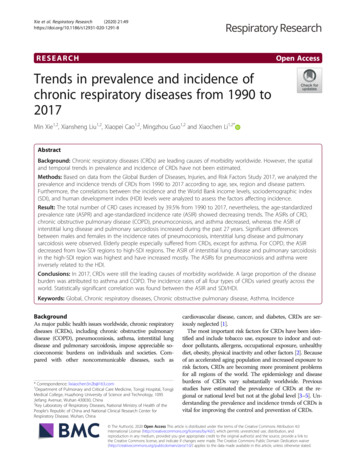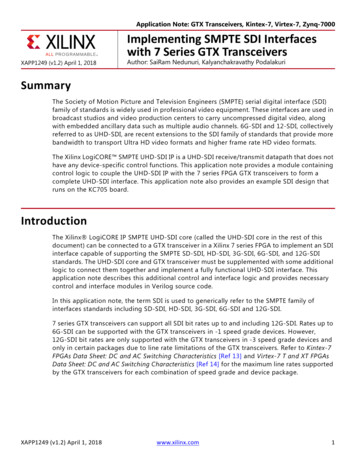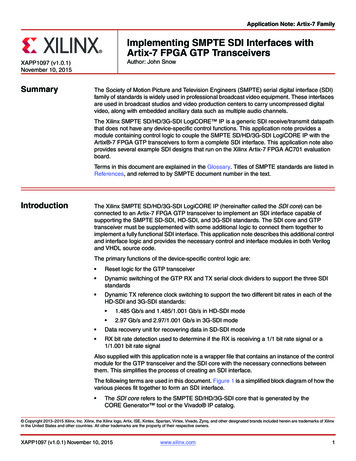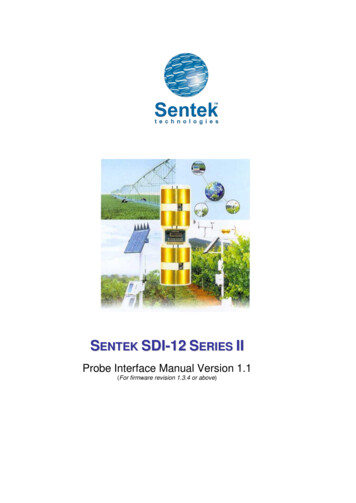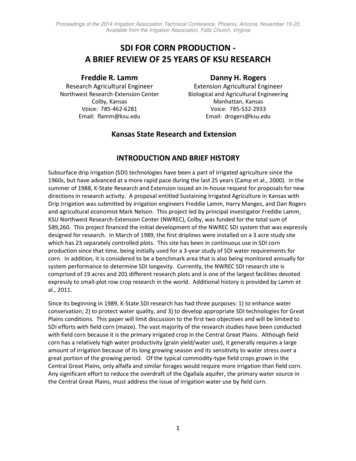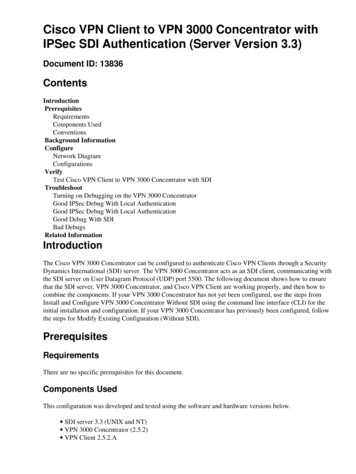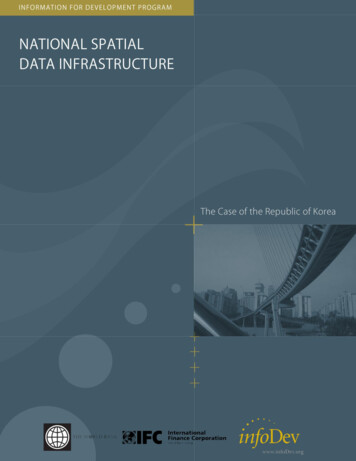
Transcription
2011 The International Bank for Reconstruction and Development / The World Bank1818 H Street NWWashington DC 20433Telephone: 202-473-1000Internet: www.worldbank.orgE-mail: feedback@worldbank.orgAll rights reservedThe findings, interpretations and conclusions expressed herein are entirely those of the author(s) and do not necessarilyreflect the view of infoDev, the Donors of infoDev, the International Bank for Reconstruction and Development/The WorldBank and its affiliated organizations, the Board of Executive Directors of the World Bank or the governments theyrepresent. The World Bank cannot guarantee the accuracy of the data included in this work. The boundaries, colors,denominations, and other information shown on any map in this work do not imply on the part of the World Bank anyjudgment of the legal status of any territory or the endorsement or acceptance of such boundaries.Rights and PermissionsThe material in this publication is copyrighted. Copying and/or transmitting portions or all of this work without permissionmay be a violation of applicable law. The International Bank for Reconstruction and Development/The World Bankencourages dissemination of its work and will normally grant permission to reproduce portions of the work promptly.For permission to photocopy or reprint any part of this work, please send a request with complete information to infoDevCommunications & Publications Department; 2121 Pennsylvania Avenue, NW; Mailstop F 5P-503, Washington, D.C. 20433,USA; telephone 202-458-4070; Internet: www.infodev.org; E-mail: info@infodev.org.All other queries on rights and licenses, including subsidiary rights, should be addressed to the Office of the Publisher, TheWorld Bank, 1818 H Street NW, Washington, D.C. 20433, USA; fax: 202-522-2422; e-mail: pubrights@worldbank.org.Cover design by infoDevCover photo by Ihcahieh.comTo cite this publication:Kim, Eun Hyung. 2011. National Data Spatial Infrastructure: The Case of the Republic of Korea.Washington, D.C: infoDev / World Bank. Available at http://www.infodev.org/publications
National Spatial Data Infrastructure: The Case of the Republic of KoreaTable of ContentsTable of Contents . ivAcknowledgments. vAbout the Author . viExecutive Summary . 1Chapter 1.Introduction . 8Chapter 2.Social Context and Theoretical Framework. 10Chapter 3.The Current Korean SDI Situation . 17Chapter 4.Korean NSDI History . 36Chapter 5.Best Practices in Korea. 45Chapter 6.Lessons Learned . 56Chapter 7.A Strategic NSDI Model for the Developing Countries . 62Annex- ANational Spatial Data Infrastructure Act . 74Annex- BSpatial Data Industry Promotin Act . 85Annex- CCurrent Status of Korean GIS Standards . 94Annex- DKorean SDI/GIS Organization List. 97Annex- ESelected List of the Korean National GIS Projects . 98Annex- FKorean GIS Expert Investigation Results . 105Annex- GTasks and Activities for SDI in Developing Countries (Example) . 111iv
National Spatial Data Infrastructure: The Case of the Republic of KoreaAcknowledgmentsThis work would not be possible without the support of numerous people and organizations whosecontributions remain invaluable to the preparation and writing of this report. Specifically, I would like tothank the Korea Trust Fund on ICT for Development and the The World Bank Group, especially Tim Kelly,team task leader of the overall “SDI for Monitoring Development Outcomes” report; Marisela MontoliuMuñoz, for her work on the original PCN; Bruce McCormack and Paul Scott, for their insightful and detailedrevisions; Samhir Vasdev, for editing and preparing this document for publication; and all reviewers whosesuggestions were deeply appreciated.v
National Spatial Data Infrastructure: The Case of the Republic of KoreaAbout the AuthorEun-Hyung Kim is a professor at Division of Landscape Architecture & Urban Planning, College ofEngineering, Kyungwon University in Korea. Since he found GIS technology in 1985, most of his lifetimehas been devoted to GIS research on national and local GIS planning and implementation. His majorresearch area is on NSDI policies, GIS standards, GIS implementations in local governments and recently,Geospatial Web and Ubiquitous City.The Korea NGIS Project, also called the Korea NSDI, started in 1995 and is now on the third phase. Thefourth phase will begin next year. He might be the only one who went through the Korea NSDI planning andimplementation from the beginning to the present. He is also deeply involved in GIS implementation in localgovernments. His most current NSDI perspective was presented by the paper, "The Prescriptive NSDIModel(2008)".Since 1995, he has been a member of Steering Committee for the NATIONAL GIS project to establish theKorean NSDI and to develop its implementation plans. He is one of the five members who initiated theNGIS project by the first-phase NGIS Implementation Plan. He has been participating in numerousAdvisory Committees in various central and local governments in Korea. Also, he is a Korean Head ofDelegate to the Technical Committee of the International Standard Organization on GeographicInformation/Geomatics (ISO/TC211).His main papers include "A Study on a GIS ISP (Information Strategic Plan) Model for Local Governmentsto Overcome the Problems in a Transition Period (2004)", "A Study on Integration Strategies for eGovernment and GIS in Korea (2005)", "Comparative Study on Advanced NSDIs for the futureNATIONAL GIS Implementation in Korea (2006)", "Study on Advanced Model for GIS Implementation inLocal Governments (2007)", and "The Prescriptive NSDI Model (2008)", which are on SDI policies fromlocal via national to international level.vi
National Spatial Data Infrastructure: The Case of the Republic of KoreaExecutive summaryThis report seeks to understand how to helpdeveloping countries advance their SDI effortsbased on the case study of South Korea. Withremarkable economic growth, South Korea standsin a unique position in the world, transformingfrom a largely aid-dependent nation to adeveloped country in a relatively short period oftime. Strategic efforts with advanced ITtechnologies have contributed considerably to itsrapid economic development, largely due to SouthKorea‟s notable NSDI effort. To investigate andanalyze the country‟s achievements as a goodpractice SDI, the current Korean SDI, this reportreviews its situation and its history. Through theanalysis, a strategic NSDI model is proposed thatcan help developing countries implement SDIefficiently.country‟s NGIS (1995-2000, 2001-2005, and 20052010). By 2008, a total of 1,2 trillion won ( 1,1billion) had been invested from public fundingfrom national budgets – 2,787 billion won ( 2,6million) in the first phase, 4,550 billion won ( 4,3billion) in the second phase, and 4,438 billion won( 4,2 billion) in the third phase. On both thenational and local levels, the plurality of NGISexpenditures was invested in creating andmanaging geospatial data and applications.It can be said that Korean SDI has been driven bya top-down approach rather than by a bottom-upapproach because the central government hasplayed a larger role to run the Korean SDI.Recently in Korea, however, a paradigmatic shiftin GIS technology from geographic informationsystems to geo-spatial information resulted in newlegislation, a change of policy from top-downapproach to a more bottom-up approach, aharmonization of both of these approaches, andorganizational arrangements for future direction.According to the 4th NGIS Plan (MLTM, 2010), anew concept of “Neogeography” will move thecurrent NSDI direction toward a “new deal” datagovernance policy with private partnerships.Under the vision of Green – focusing ance, and easy access to spatial information– the “everywhere”, “everybody,” and “new deal”policy will begin to guide the country‟s NGIS.The current Korean SDI situationThe current Korean SDI situation can beidentified by 12 issues: GIS applications, policyissues, legislation, organizational issues, funding,data sets, standards, software and networkservices, access issues, international issues,evaluation, and education/research. These issuesfit neatly into six primary components of SDI(data, standards, access and metadata, policy,technology, and partnerships) as follows: 1) Datasets can be mapped to the data component; 2)Standards issues to the standard component; 3)Access issues to the access and tional issues to the policy component; 5)Software and network services issues to thetechnology component; and 6) n/research issues to the partnershipscomponent. These components are interrelatedthrough mutual interactions.South Korean NSDI historyIt should be said that Korean SDI history cannotbe separated from the NGIS project since bothevolved together. In other words, from simpledigitization of information to knowledge, KoreanSDI developed and changed rapidly through theimplementation of various NGIS projects. Thistransformation can be illustrated by examining thethree phrases of NGIS:With regards to the important issue of funding, alarge amount of the Korean budget had beeninvested throughout the three phases of the1
National Spatial Data Infrastructure: The Case of the Republic of KoreaTable 1: The three phases of Korea's NGISGoalNGIS Phase 1 (1995-2000)Digitization of spatial data toestablish GIS infrastructure inorder to promote to nationalcompetitiveness andproductivityNGIS Phase 2 (2001-2005)Construction of a wider GISdigital landscapeNGIS Phase 3 (2005-2010)Emphasis on theinfrastructure of theimplementation of KoreanUbiquitous LandHuman resourceTechnologyStandardApplicationDataCreation of digital topographicand cadastral mapsDigital thematic map, parceladdress map, administrativeboundary map, road map,current land use map, nationalland zoning map, and urbanplanning mapGIS application forunderground facilityDevelopments of severalstandards including standardfor national base map,underground facility mapDevelopments of standards forexchange of spatial dataMapping technology, DB Tool,GIS S/W technologyIT labor markets promotionprojectOffline GIS educationFundamental data includingadministrative district,transportation, marine andwater resources, etcGIS application forunderground facility , land use,environment, agriculture,marineDevelopments of severalstandards including standardfor framework, data,construction, distribution andapplication for NGISNational /marine base mapNational geodetic controlpoint, national imagery DBLinkage and integration ofindividual GIS applicationsystems3D spatial information, UPIS,KOPSS, BIM etc.Re-establishment offramework data standardDevelopments of advancedseveral standardsModification andsupplementation of existingstandards3D GIS, high-resolution RStechnologyIntelligent land informationbased on GIS technologyand developed new softwarefor the future informationoriented society.Online and offline GISeducationOnline and offline GISeducationDevelopment of educationalprogram and educationaltextbookUpdate of educationalprogram and educationaltextbook2
ResearchClearinghouseNational Spatial Data Infrastructure: The Case of the Republic of KoreaPilot project for national spatialclearing houseProject for national spatialclearing house 70m datasets in139 categories availableAdvancement project formanagement of nationalspatial clearing houseResearch for NGISResearch for NGIS in mid- andlong-term policy projectResearch for NGIS inchanging environmentsLessons learned from NSDILessons learned by the Korean NSDI align withthe 6 components of SDI discussed earlier (data,policy, standard, access and metadata, technology,and partnerships), and with the additional metricof GIS applications:Table 2: Lessons learned from Korea's NSDIDataSDIcomponentLessons learnedRecommendationIn South Korea, an over-emphasis ondata accuracy has retarded thedevelopment of SDI. Harmonizing aconcept of data quality in users‘perspective with suppliers‘ perspectiveis important for data production,usages and various applicationsHarmonization of cost with quality isimportant.The strategies for data updating mustbe considered during initial databuilding to prevent duplicatedinvestment for revision and dataupdating.3Efforts to bridge gaps betweenassessing formal institutional data qualityand informal real usage for businessFor example, using digital ortho-photo,satellite image or new surveyingtechnology can be preferable to usingtraditional surveying methods.For rapid return on investment, theselection of maps at proper scale anddecision on data building method willneed to be reviewed.Tools such as UFID for efficient and realtime updating will be useful.
StandardsNational Spatial Data Infrastructure: The Case of the Republic of KoreaIn the South Korean SDI, two kinds oflevel as de jure standards havedeveloped: KS and TTA standards. ToDeveloping the standards whileobtaining consensus, will inevitablytake considerable time.As a result, several NGIS projects havebeen implemented without relatedstandards.Strategic standardization based onconsensus among GIS communities forSDI, more effectively and easily.Tools such as the USGS geospatialbluebook, the standards guidanceresource, are useful at theimplementation and conceptual levels.PolicyTechnologyA delay of NGIS standardization resultsin issues of data interoperability andproject inefficiency.In spite of the development of GIStechnologies for the 3 NGIS phases, theadoption of advanced foreigntechnologies is significant in Korea.With the help of ubiquitoustechnologies, Korea competitivelydevelops specific technologies.Due to a lack of best practicse in theuse of technologies from the get-go,educational programs for GIStechnologists and experts are crucial.Wider strategical use of open-sourcetechnologies is recommended.Strategic and rapid development ofselected technologies for developingcountries‘ SDI is recommended.More administrative experts and fewerGIS experts as decision makers mayhave resulted in some trial and errors atthe beginning of NGIS phase in SouthKorea.Legislation for the NSDI at a nationaland local level is required for SDI. In duetime, legislation for SDI must beintroduced with a a clear definition ofroles defining who does what.Conflicts between the GIS andsurveying communities could presentproblems, and the latter‘s influence hasbeen more substantial than the formergroup‘s. Accuracy has prevailed overfitness for use. It has retarded GISapplications to bloom. ?More participation and determinationof GIS experts in policy-making processis needed.Tools such as a NGIS Master Plan inevery phase of NGIS in Koreapresented a vision, tasks, project andbudgets, with the SDI Master Plan first.4Strategic and sustainable Master Plansfor SDI First, according to Master Plan,implementation Plan is also needed. -?As with the Korean case, evaluationfollowing implementation is alsoneeded.
PartnershipsApplicationAccess & MetadataNational Spatial Data Infrastructure: The Case of the Republic of KoreaStandards for metadata and datacatalogue are required to distribute andshare data via the NGIS One StopPortal.Online or off line distribution networksare essential for successful SDI.NGIS ―One Stop Portal‖ for accessservice and linkage of e-governmentportal with NGIS portal are useful.To spure adoption of the VGI concept,poor knowledge of data availabilityshould be overcome and access tospatial data .Many GIS applications are developedand used for efficient resourcemanagement throughout the 15-year,3-phase NGIS in South Korea.The recent trend of users making theirown GIS applications using OpenAPIhas significant implications fordeveloping countries. For example,Open API services are available inSeoul and Daegu at the local level.Strong government leadership andorganisational partnership areimportant.The delayed establishment of NGISstandards during the 2nd phase wasdue to a lack of organizationalpartnerships.Considering the limits of resources indeveloping countries, for efficientbudget allocation, priorities amongvarious GIS applications would beincluded in the master plan. To provideinteroperability of GIS applications, ageo-Web platform is useful.Rapid return on investment of GISapplications must also be considered.Efficient institutional reorganization andregulations required to promotepowerful organization partnerships.For example, as Chairperson of NationalSpatial Data Committee, the Presidentprovided powerful leadership, ratherthan the minister of land, transport andmaritime affairs. This alleviates thepotential obstacles of weakerleadership, inter-organizational conflict,and a lack of cooperation betweengovernment agencies.A strategic NSDI model for developingcountriesfor the development of SDIs at the national levelwith reference to the local level.This report proposes a strategic NSDI model fordeveloping countries based on South Koreanlessons highlighted above and on the opinions ofKorean GIS experts. This model includes 4strategies, including strategies for geospatial data,GI capacity building, GI portal enabling accessplatforms, and cost-effective management of GIwith partnerships, all of which can be establishedIn developing countries, due to a lack of variousresources such as financial and human capital, toppriority must be given to a product-based model.Given varying political, economic, and culturalcircumstances in developing countries, thefindings of this report will have differentimplications for different countries. However,primary consideration might be given to thecreation of geospatial data.5
National Spatial Data Infrastructure: The Case of the Republic of KoreaSTRATEGIESDATAFORGEOSPATI ALmost successful in taking advantage of local andnational geographic information assets insituations where the capacity exists to exploit theirpotential. This is particularly important indeveloping countries where the implementation ofSDI initiatives is often dependent on a limitednumber of staff with necessary geographicinformation management skills. It must also berecognized that there remains a great deal to bedone to develop GIS capabilities, particularly atthe local level. GIS capacity-building can beconsidered in the adoption and vitalization of theVGI concept for future SDI development.Like NGII‟s digital topographical map at 1:1.000scale covering almost all of the countries in theKorean SDI, high quality geospatial data such as adigital topographical map makes successful SDIimplementation possible. However, the digitaltopographic map database is also likely to be anexpensive task that takes place over a relativelylong period of time. Using new technologies,strategies for geospatial data for developingcountries can exploit alternative informationsources such as remotely-sensed data in additionto conventional survey technology. For example,Openstreetmap, which is a wiki-style VGI(Volunteered Geographic Information) mapusing various mapping techniques includingremote mapping and sketching over aerial imagerywith GPS unit, can be a possible method to builda basic map efficiently. A great deal can be done inthis way without incurring the delays that areinevitably associated with conventional databasecreation.STRATEGIES FOR GI PORTALENABLING ACCESS PLATFORMSWithout enabling access platforms, and theappropriate metadata services which help them tofind this information, it is unlikely that a SDI willbe able to achieve its overarching objective ofpromoting greater use of geographic information.There is also a practical reason that thedevelopment of metadata services should be givena high priority in the implementation of a SDI:These services can be developed at relatively lowcosts and high speeds. In this respect, they can beregarded as potential “quick winners” whichdemonstrate tangible benefits for those involvedin SDI development.Additionally, in Korea‟s experience processingfurther NGIS projects, not only buildinggeospatial data but also maintaining it for sharingand utilizing is of paramount importance. In thiscontext, it is more important to make datainteroperable for data sharing and utilization.Thus, standardization is a prerequisite to buildingand sharing geospatial data, information, lity of geospatial data and servicesshould be developed according to the consensusof stakeholders.The establishment of Web-based metadataservices provides information to users about thedata that is available to meet their needs. It is alsoone of the most obvious SDI success stories. Inrecent years, the development of spatial portalshas opened up new possibilities for metadata andapplication services. As their name suggests,spatial portals can be seen as gateways togeographic information (GI) resources. As suchthey provide points of entry to SDIs and helpusers around the world identify and connect tomany GI-rich resources. These portals also allowGI users and providers to share content andcreate a consensus. Also, for better citizen spatialservice , integration and linkage of e-governmentand NSDI should be done from the beginning ofthe project timeline to avoid duplication of efforts.Furthermore, in the context of recent trendstoward vitalization with the adoption of the VGIconcept, poor knowledge of data availabilityConcerning the matter of financing, the cofunding model reliant on international funds(building topological maps with central and localgovernments in South Korea) serves as a goodreference for developing countries withinsufficient budgets.STRATEGIESBUILDINGFORGICAPACI TY -Due to poor human resources, misunderstandingor lack of technological accuity in developingcountries, strategies for GI capacity-building arealso of high importance. SDIs are likely to be6
National Spatial Data Infrastructure: The Case of the Republic of Koreashould be improved and access of spatial dataextended.This same strategy is needed for SDI indeveloping countries, wherein SDI coordinatingbodies should play a key role.Like the NationalSpatial Data Committee in South Korea, aninteragency committee is necessary to deliberateon and coordinate matters concerning nationalspatial data policy and to promote the coordinateddevelopment, use, sharing and dissemination ofgeospatial data and services. Finally, legislation forthe NSDI at the national and local levels isrequired embrace the importance of SDI and toencourage a technological mindset.STRATEGIES FOR COST-EFFECTIVEMANAGEMENT OF GI WITHSTRONG LEADERSHIP ANDPARTNERSHIPSStrong government leadership and organizationalpartnerships have been evaluated as a primarydrive to successful NSDI, as mentioned earlier. Inorder to pursue a more powerful alreorganization and regulations are required.The South Korean SDI case reveals that strong,top-down, national NSDI leadership by thecentral government is important to successful SDIimplementation from the start.7
National Spatial Data Infrastructure: The Case of the Republic of KoreaChapter 1: IntroductionMany countries worldwide including bothadvanced and developing are engaged in SDIdevelopment, which involves the development ofgeospatial services that support public servicedelivery, ultimately to promote economicdevelopment, stimulate better government, nt ranges from local to state/provincial,national and regional levels, to a global level. SDIis now moving to underpin an information societyand enable a society to be spatially enabled,(Rabajifard, 2006a).In this context, there is a common need forknowledge on “how to” guide on thedevelopment of spatial data infrastructure (SDI) ata national level.Contents of this reportThis report provides a reference on thedevelopment of spatial data infrastructure (SDI) ata national level for developing countries. Based onrecent SDI-related activities in Korea, and historyof Korean SDI with best practices in Korea, astrategic NSDI model is suggested for developingcountries. The report is divided into three partswith seven chapters by concept.SDI can be seen as a framework of spatial (GIS)data, metadata, users and tools (services) that areinteractively connected in order to use spatial datain an efficient and flexible way. Due to its nature(size, cost, number of inter-actors), an SDI isusually government-related. SDIs and the broaderuse of GIS create an improved informationenvironment worldwide.Social change, economic growth, andSDIThe first part of the report examines the socialbackground and theoretical reviews. Tounderstand SDI in relation to South Koreanhistorical, economic, and social background,Chapter 2 shortly reviews South Korean recenthistory of social change and economic growthsince the Korean War. Next, SDI theoreticalframework will be described with conceptualbackground and directional envision for the SouthKorean SDI investigation in practice.With the increased generation and use of GIS datanecessitates, however, the need for standardizing,organizing, storing, managing and sharing thembetter. Increasingly aware of the material andopportunity costs of bad GIS managementpractices, developing countries are nowapproaching for advice on how to develop soundSpatial Data Infrastructures (SDIs) – that is, thetechnologies, policies, standards, and humanresources necessary to acquire, process, store,distribute and improve utilization of geospatialdata.The South Korean situationThe second part of the report draws about thestatus quo and history of South Korean SDI, thatis, the current Korean SDI Situation (Chapter 3),History of Korean SDI (Chapter 4), Best Practicesin Korea (Chapter 5) and Lessons Learned(Chapter 6).To synthesize lessons from global experience onhow countries can manage GIS, nt) the technical challenge ofbuilding an SDI, the most critical issues andobstacles often emerge on the institutional,organizational, and financial fronts – that is, in thedefinition of the roles and responsibilities fordiverse actors working with and benefitting fromthe SDI. In terms of it, institutional governance isnecessary for effective and efficient spatial dataand services management within or acrossorganizationsThe Current Korean SDI Situation (Chapter 3)reviews 12 issues, GIS applications, policy issues,legislation, organizational issues, funding, data sets,standards, software and network services, accessissues, and international issues, evaluations, andeducation/research.8
National Spatial Data Infrastructure: The Case of the Republic of KoreaHistory of Korean SDI (Chapter 4) introduces 3phases of the NGIS project. The results of theproject are analyzed and evaluated both at anational and a local level.A strategic NSDI model for developingcountriesThe final part of the report addresses about astrategic SDI model for the developing countriesbased on previous chapters mentioned. The modelprovides a “how to” guidance including keyfactors and choices to have in mind in thedevelopment of SDIs at the national level withreferencing at the local level. At the same time,SDI development is a longer-term and nonlinearprocess requiring a high level of coordinationamongst different ministries and private entitiesthat manage different data sets and providenecessary network services. Therefore, the key toits success may be highly context-specific.However, in the context of South Koreanexperience, several tasks for strategic SDIdevelopment proposed use of GIS to producedevelopmental outcomes for the developingcountries (Chapter 7).Based on the evaluation by GIS Experts andexisting NGIS evaluation reports, Best Practices inSouth Korea (Chapter 5) are selected to exemplifygood NSDI characteristics in central and localgovernments.Lessons Learned (Chapter 6) is discussed in 6 SDIcomponents such as 1) Data; 2) Law/institution,3) Standards; 4) Ac
practice SDI, the current Korean SDI, this report reviews its situation and its history. Through the analysis, a strategic NSDI model is proposed that can help developing countries implement SDI efficiently. The current Korean SDI situation The current Korean SDI situation can be identified by 12 issues: GIS applications, policy


